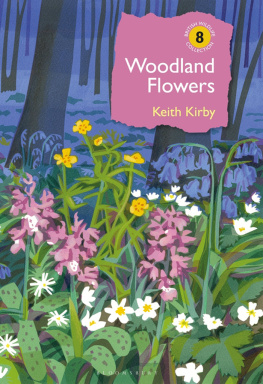Dedication
This book celebrates the two hundredth anniversary of the publication of the first book on ferns in these islands (and the first book on ferns in the world), that of James Boltons Filices Britannicae, published in Leeds and Huddersfield, Yorkshire in 17851789. It also commemorates the enormous stimulus to pteridology of the work of Professor Irene Manton, FRS (19041988), from her first second-generation student.
Max Walters, ScD, VMH
Professor Richard West, ScD, FRS
David Streeter, FIBiol
Photographic Editor
Eric Hosking, OBE, Hon FRPS, FBIPP
The aim of this series is to interest the general reader in the wildlife of Britain by recapturing the enquiring spirit of the old naturalists. The Editors believe that the natural pride of the British public in the native flora and fauna, to which must be added concern for their conservation, is best fostered by maintaining a high standard of accuracy combined with clarity of exposition in presenting the results of modern scientific research.

Some New Naturalist volumes have a very long gestation period, and this welcome new book on Ferns brings to fruition a project that was seriously discussed more than forty years ago when the New Naturalist library was in its infancy. Dr Page, in his Authors Preface, indeed, tells us of a charming coincidence in a Devon lane that reminded him of this fact. We are extremely fortunate to have found, in the new generation of pteridologists, an author as competent and enthusiastic as Chris Page to write this book for us. Not only is the author a professional scientist interested in the Pteridophyta of the world, but he is also an amateur naturalist with a love for the ferns of the British Isles. This combination of talent is ideal for the New Naturalist series, which has always aimed to combine a high standard of accuracy with a stimulation of the natural pride of the British public in their wild animals and plants.
The relationship between the contents of this volume and Dr Pages earlier book on The Ferns of Britain and Ireland (Cambridge University Press, 1982) perhaps needs a little clarification. The two books are designedly complementary: the 1982 volume is a modern, detailed Pteridophyte Flora of the British Isles, in which full taxonomic treatment is given to every native species, whilst our present volume deals essentially with the ecology of British pteridophytes, grouping them mainly under contrasting habitats and discussing their adaptations to the conditions of those habitats. Ideally, the reader might possess both books, but of course the New Naturalist volume is totally self-explanatory and provided with an appended checklist of species.
There is a further reason for pleasure in adding this volume to our series. It is in fact 25 years since the last purely botanical New Naturalist book was published (Sir Edward Salisburys classic on Weeds and Aliens, a revision of which is currently being undertaken by Dr Akeroyd), and the Editors greatly welcome this move to redress the balance somewhat between the different branches of natural history. Let us hope that in the near future we can fill other long-standing gaps in our botanical coverage as satisfactorily as the fern gap has been filled.

Shortly after completing an earlier taxonomic book for the indentification of the ferns of Britain and Ireland (Cambridge University Press, 1982), I was teaching one of my field courses at Slapton Field Studies Council centre in south Devon. One evening, I left my group working in the laboratory, while I wandered out into the nearby lanes to photograph ferns that I had seen there earlier in the day. It was a beautifully still, warm, Devonshire evening. The light remained good, and only at this time of day did the lane seem free enough of traffic to set-up my camera and tripod with any great safety.
Whilst giving an attractive spleenwort due photographic attention, I was surprised by an elderly, Devonian voice from behind me. Its owner had clearly been watching my antics, and had arrived unseen. Im photographing ferns growing amongst the lanebank stones, I explained to him, with all the speed of purpose that the infectious pace of rural Devonshire, and my own west-country upbringing, usually muster.
I once photographed ferns was the surprising reply, and, of course, we fell into one of those mutually curious conversations on the chance meeting of two fellow interests that seems to happen on but few occasions in most lifetimes.
He went on to explain that he had been a professional photographer, and that one of his jobs before he retired had been to photograph British ferns. Fascinated I probed further, and was amazed as he recounted that this had been as a commission to illustrate a book on ferns.
I asked, in great curiosity, what book this was. It was for Collins, for their New Naturalist series he detailed, and added: That was about 1947, but the book was never written.
There have been few times in my life, as a scientist, that I have ever felt quite so amazed at the statistical improbability of such an event. For it was now my turn to explain to this benevolent and aged gentleman that the person he had just told that tale to was the one who, just a few months before, had been approached by Collins to write just the book he is talking about. We eventually retired, each still continuing to recount the story to the other again, just in case the whole conversation had been merely the misheard echo of a quiet Devon lane.
This book is thus the result of those labours (or at least of mine), and of this strange co-incidence of events. For there is regretfully no longer any trace of these former photographs. But this meeting eased me into the knowledge of the gestation period of this particular book which, as I calculate it, was conceived (by others), as part of the New Naturalist series, when I was about five years old.
About that time, however, and unknowing of more worldly things, I was busy adopting two impressions of plants of my own. One took the form of many piles of rocks, gleaned like a jackdaw and examined with ever-increasing delight and curiosity. These came from the numerous spoil heaps of small coal workings, from which I could collect ample specimens, in the Forest of Dean. The many fossils in these were distinctly of plants, of recognisable fragments of wood, many curiously jointed stems, and distinctive and beautiful foliage, not unlike that of the ferns that grew around me. All of these I treasured. The other occurred in annual holidays to the Cambrian coast of Wales, where the beach sand fascinated me less than did the thick masses of succulent, white-stemmed, jointed shoots of plants through which I had to push to get there. They seemed to tower around me like something out of a fairy tale. I came to regard them as something special, about which I wanted to know more, the more so because I could also see a likeness between them and some of my fossils. Thus both horsetails and ferns each came to have a special and enduring fascination. Nature knew how to capture the attention of a small boy; rather more than did many school lessons of the day.
Nearly forty years on, and a university thesis on horsetails somewhere in between, it is perhaps due time therefore that this book appeared. I can therefore only apologise to those readers who have duely passed-on while waiting.








